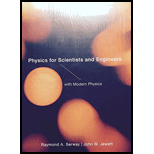
Concept explainers
Monochromatic coherent light of amplitude E0 and angular frequency ω passes through three parallel slits, each separated by a distance d from its neighbor. (a) Show that the time-averaged intensity as a function of the angle θ is
(b) Explain how this expression describes both the primary and the secondary maxima. (c) Determine the ratio of the intensities of the primary and secondary maxima. Hint: See Problem 16.
(a)
To show: The time averaged intensity as a function of angle
Answer to Problem 26P
The time averaged intensity as a function of angle
Explanation of Solution
Given info: The amplitude of monochromatic light is
The amplitude of the monochromatic light is,
Here,
The total amplitude of monochromatic light is,
Substitute
Apply the trigonometric identity to the above expression as,
Apply the trigonometric identity to the above expression as,
Add the above result to
As it is known that intensity of monochromatic light is directly proportional to the the square of the electric field that is,
Here,
The resultant field is obtained by square the above expression as,
Substitute
Conclusion:
Thus, the time averaged intensity as a function of angle
(b)
The way in which the expression describes both the primary and secondary maxima.
Answer to Problem 26P
The expression describes both the primary and secondary maxima.
Explanation of Solution
Given info: The amplitude of monochromatic light is
From the above expression obtained in part (a), the minimum interference is obtained when
Conclusion:
Thus, the expression describes both the primary and secondary maxima.
(c)
The ratio of the intensities of the primary and secondary maxima.
Answer to Problem 26P
The ratio of the intensities of the primary and secondary maxima is
Explanation of Solution
Given info: The amplitude of monochromatic light is
Consider the amplitude of the monochromatic light is,
The total amplitude of monochromatic light is,
Substitute
Apply the trigonometric identity to the above expression as,
Apply the trigonometric identity to the above expression as,
Add the above result to
As it is known that intensity of monochromatic light is directly proportional to the square of the electric field that is,
Here,
The resultant field is obtained by square the above expression as,
Substitute
The expression for the intensity for primary maxima is,
The expression for the intensity for secondary maxima is,
Take the ratio of the above two expression as,
Conclusion:
Therefore, the ratio of the intensities of the primary and secondary maxima is
Want to see more full solutions like this?
Chapter 37 Solutions
Physics For Scientists And Engineers With Modern Physics, 9th Edition, The Ohio State University
- I need correct answer not chatgptarrow_forwardWhat is the resistance (in (2) of a 27.5 m long piece of 17 gauge copper wire having a 1.150 mm diameter? 0.445 ΧΩarrow_forwardFind the ratio of the diameter of silver to iron wire, if they have the same resistance per unit length (as they might in household wiring). d. Ag dFe = 2.47 ×arrow_forward
- Find the ratio of the diameter of silver to iron wire, if they have the same resistance per unit length (as they might in household wiring). d Ag = 2.51 dFe ×arrow_forwardShow that the units 1 v2/Q = 1 W, as implied by the equation P = V²/R. Starting with the equation P = V²/R, we can get an expression for a watt in terms of voltage and resistance. The units for voltage, V, are equivalent to [? v2 v2 A, are equivalent to J/C ✓ X . Therefore, 1 = 1 = 1 A V1 J/s Ω V-A X = 1 W. . The units for resistance, Q, are equivalent to ? The units for current,arrow_forwardPlease solve and answer the question correctly please. Thank you!!arrow_forward
 Principles of Physics: A Calculus-Based TextPhysicsISBN:9781133104261Author:Raymond A. Serway, John W. JewettPublisher:Cengage Learning
Principles of Physics: A Calculus-Based TextPhysicsISBN:9781133104261Author:Raymond A. Serway, John W. JewettPublisher:Cengage Learning Physics for Scientists and Engineers: Foundations...PhysicsISBN:9781133939146Author:Katz, Debora M.Publisher:Cengage Learning
Physics for Scientists and Engineers: Foundations...PhysicsISBN:9781133939146Author:Katz, Debora M.Publisher:Cengage Learning University Physics Volume 3PhysicsISBN:9781938168185Author:William Moebs, Jeff SannyPublisher:OpenStax
University Physics Volume 3PhysicsISBN:9781938168185Author:William Moebs, Jeff SannyPublisher:OpenStax Modern PhysicsPhysicsISBN:9781111794378Author:Raymond A. Serway, Clement J. Moses, Curt A. MoyerPublisher:Cengage Learning
Modern PhysicsPhysicsISBN:9781111794378Author:Raymond A. Serway, Clement J. Moses, Curt A. MoyerPublisher:Cengage Learning Glencoe Physics: Principles and Problems, Student...PhysicsISBN:9780078807213Author:Paul W. ZitzewitzPublisher:Glencoe/McGraw-Hill
Glencoe Physics: Principles and Problems, Student...PhysicsISBN:9780078807213Author:Paul W. ZitzewitzPublisher:Glencoe/McGraw-Hill College PhysicsPhysicsISBN:9781285737027Author:Raymond A. Serway, Chris VuillePublisher:Cengage Learning
College PhysicsPhysicsISBN:9781285737027Author:Raymond A. Serway, Chris VuillePublisher:Cengage Learning





